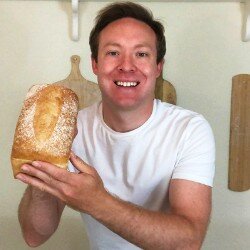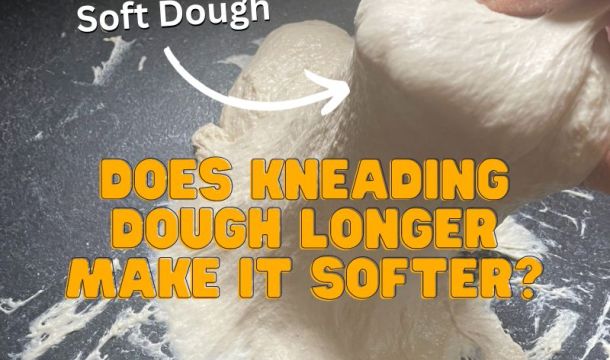
How To Get More Yeasty Flavour In Bread?

While there are people who don’t like the yeasty taste of their bread, there are those who prefer having them. Sometimes, people even want to emphasise it. If you’re one of those who love the yeast flavour of homemade bread, here are some tricks that can help you to produce a more “yeasty” flavour in bread.
For bread to taste more yeasty you need to add more yeast to the recipe. The challenge that many bakers encounter when doing this is proofing the bread correctly. More yeast means a faster rise which often results in a loaf that collapses or has a poor crumb structure.
So, if you want to emphasise the yeast taste in your bread and want a pleasant-looking loaf, here are some tricks that you can do:
Use inactivated yeast to make bread taste yeasty
The best way to make bread taste more yeasty is to add inactivated yeast to the recipe. This will make your bread taste of yeast but without speeding up the rise. It will weaken the gluten; therefore, don’t add too much! A teaspoon (3 grams) is a good place to start.
Add more yeast for a more yeasty flavour
The most obvious way to make bread taste more yeasty is to add more yeast. Most bread recipes contain around 1.8-2.2% yeast of the total flour weight (see baker’s percentages). To make the bread taste more like yeast, increase the amount to 2.5% or higher. Of course, if this happens, you will find that the dough rises a lot faster! Here are some tips to consider if using this method:
– Don’t add too much sugar
Yeast uses sugar to feed on. But of course, don’t overdo it! Too much yeast and sugar will make your bread rise quicker, but you don’t want to use up all the yeast. You want some yeast remaining to perfume the bread. A yeasty flavour often needs a bit of sweetness to make it taste nice, so add a teaspoon per loaf to start with.
– Knead quickly to develop the gluten
Because your dough will rise quickly, you must develop the gluten in the mixing bowl. You won’t be able to bulk ferment as the dough will become too gassy and unmanageable. Knead the dough to pass the windowpane test and get it shaped and risen soon after.
– Add vinegar to support the dough structure and the yeast
The use of vinegar in bread dough is perfect for flavour and to enhance the structure of the dough. Just a teaspoon per loaf can improve the quality of your bread.
– Use ascorbic acid to support the dough structure
As you won’t be able to bulk ferment an overly yeasty dough adding some ascorbic acid will support its structure. Being an oxidizing agent, it increases the strength of the gluten bonds and also acts as a dough conditioner.
Add a bit of malt flour
Malt flour has similar earthy, rustic flavours to yeast. Adding malt flour to your bread recipe might be a sensible solution. You can add this as well as inactivated yeast or if using more yeast.
The deactivated version is preferred, especially if you are adding more yeast to the dough, as activated malt flour will break down the sugars in the flour quickly and speed up the rise. Add 5% deactivated malt flour to your recipe to start with.
Use fresh bakers yeast
Instant yeast has the most active yeast cells out of all the types of yeast. This makes it more effective, so less is required. For a yeasty flavour in bread we want to add more, not less, yeast.
Active dried yeast contains more unactive cells, therefore, is best for a yeasty flavour. Baker’s compressed (cake) yeast adds more interesting flavour, so if you can get it, you might want to use it here.
Use nutritional yeast usable for bread making?
Nutritional yeast undergoes a deactivation process, wherein the yeast cultures are killed by heat. So if it’s used for baking, it won’t be able to leaven your baked goods, although it will add a yeasty flavour. Add 2 teaspoons per loaf.
Select recipes with fewer additional ingredients
Ingredients such as eggs, butter, sugar, and so on enhance the flavour of the bread. Yet they will mask the yeasty flavour, so they are best avoided if you want your bread to taste yeasty.
Yeast extract
A jar of yeast extract is a great way to add the flavour of yeast to bread. It’s deactivated, so it won’t affect the rise yet, do reduce the salt in the recipe, as it’s usually very salty! Add 2 teaspoons per loaf.
Frequently asked questions on yeast for bread making
If you’ve enjoyed this article and wish to treat me to a coffee, you can by following the link below – Thanks x

Hi, I’m Gareth Busby, a baking coach, senior baker and bread-baking fanatic! My aim is to use science, techniques and 15 years of baking experience to make you a better baker.
Table of Contents
Related Recipes
Related Articles
Latest Articles
Baking Categories
Disclaimer
Address
53 Greystone Avenue
Worthing
West Sussex
BN13 1LR
UK







